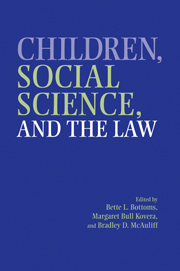Book contents
- Frontmatter
- Contents
- Acknowledgments
- Contributors
- 1 Children, Social Science, and the Law: An Introduction to the Issues
- PART I CHILDREN'S RIGHTS, THEIR CAPABILITIES, AND SOCIETY'S RESPONSIBILITIES TO CHILDREN
- PART II CHILDREN AND FAMILY CHANGE
- 6 Termination of Parental Rights to Free Children for Adoption: Conflicts between Parents, Children, and the State
- 7 Child Custody Research at the Crossroads: Issues for a New Century
- 8 Children of Lesbian and Gay Parents: Research, Law, and Policy
- PART III JUVENILE AGGRESSION AND JUVENILE JUSTICE
- PART IV CHILDREN AS VICTIMS AND WITNESSES
- PART V CONCLUSIONS AND FUTURE DIRECTIONS
- Author Index
- Case Index
- Subject Index
- References
7 - Child Custody Research at the Crossroads: Issues for a New Century
Published online by Cambridge University Press: 24 July 2009
- Frontmatter
- Contents
- Acknowledgments
- Contributors
- 1 Children, Social Science, and the Law: An Introduction to the Issues
- PART I CHILDREN'S RIGHTS, THEIR CAPABILITIES, AND SOCIETY'S RESPONSIBILITIES TO CHILDREN
- PART II CHILDREN AND FAMILY CHANGE
- 6 Termination of Parental Rights to Free Children for Adoption: Conflicts between Parents, Children, and the State
- 7 Child Custody Research at the Crossroads: Issues for a New Century
- 8 Children of Lesbian and Gay Parents: Research, Law, and Policy
- PART III JUVENILE AGGRESSION AND JUVENILE JUSTICE
- PART IV CHILDREN AS VICTIMS AND WITNESSES
- PART V CONCLUSIONS AND FUTURE DIRECTIONS
- Author Index
- Case Index
- Subject Index
- References
Summary
Domestic relations cases, including divorce, child custody, child support, paternity, domestic violence, and adoption filings, compose the fastest-growing sector of cases that come before our states' courts. The National Center for State Courts reports a 65% increase in domestic relations filings between 1985 and 1997 (Ostrom & Kauder, 1997).
The widesweeping impact of child custody policy and practice is evident when we consider that more than half of all children born today will live apart from one parent at some time during their childhood (Furstenberg & Cherlin, 1991). All of these children are potentially subject to child custody orders. Although a great deal of research has focused on custody following divorce, this literature is not sufficient to advise child custody policy makers. Divorce accounts for little more than half of the children who live in single-parent households. The others are born to parents who do not marry (U.S. Bureau of the Census, 1992). Child custody cases may enter the courts because a divorce is in progress, a paternity case is being heard, child support orders are being established, or as part of domestic violence restraining orders. Because divorce is only one family law proceeding that involves child custody orders, the term family reorganization is used in this chapter to refer the wider spectrum of family circumstances that lead to child custody decisions.
- Type
- Chapter
- Information
- Children, Social Science, and the Law , pp. 153 - 175Publisher: Cambridge University PressPrint publication year: 2002

